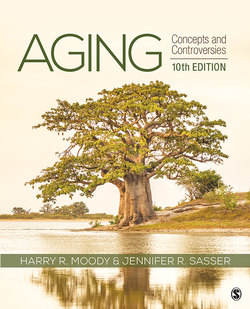Читать книгу Aging - Harry R. Moody - Страница 74
На сайте Литреса книга снята с продажи.
Aging-Clock Theory
ОглавлениеAccording to the aging-clock theory of aging, aging is programmed into our bodies like a clock ticking away from the moment of conception. One of the best examples of an aging clock in humans is the menstrual cycle, which begins in adolescence and ends with menopause. The aging-clock theory is part of programmed aging, in which aging is seen as a normal part of a sequence leading from conception through development to senescence and finally to death.
One version of the aging-clock theory emphasizes the roles of the nervous and endocrine systems. This version postulates that aging is timed by a gland, perhaps the hypothalamus, the thymus, or the pituitary gland. Such a gland acts like an orchestra conductor or a pacemaker to regulate the sequence of physiological changes that occur over time. Some support for this idea comes from observations that the hormone dehydroepiandrosterone (DHEA) is found in higher levels among younger people. Experimenters have also discovered that DHEA supplements help laboratory rats live longer.
The aging-clock theory has encouraged research on the role of hormones secreted by the thyroid, pituitary, and thymus glands (Lamberts, van den Beld, & van der Lely, 1997). These include human growth hormone, which can now be manufactured in quantity through genetic engineering. In experiments, volunteers injected with growth hormone lost flabby tissue and grew back muscle, essentially reversing some manifestations of the aging process for a time. Other investigators are interested in hormones produced by the pineal gland, which may help regulate the “biological clock” that keeps time for the body.
Hormones and the endocrine system clearly play a major role in the process of aging. Hormones control growth, development, and reproduction in plants and animals. Biologists recognize a phenomenon here called semelparity. The best example is the Pacific salmon, which swims upstream to lay its eggs and then dies. So-called annual plants also exhibit semelparity: The tomato plant flourishes, produces fruit, and then dies away as the autumn leaves begin to fall.
But we find no comparable biological process in humans. We do recognize the profound age-related hormonal change of menopause, which comes with the loss of cells in the ovary that produce estrogen. Female mammals are born with a finite number of egg cells, so menopause is an example of a preprogrammed life event linked to age. Menopause is not a disease itself—it is, rather, a normal part of aging—but it is tied to health problems of aging because the loss of estrogen often weakens bone-mineral metabolism, resulting in thinner bone structure—a condition known as osteoporosis. Thin bones can lead to fractures, which in turn may compromise an older person’s ability to live independently.
Biogerontology continues to search for a “magic clock” that would give definitive knowledge of biomarkers to measure aging. Recently, scientists have begun to use artificial intelligence as a tool to chart aging at the deepest possible level (Zhavoronkov & Mamoshina, 2019).
